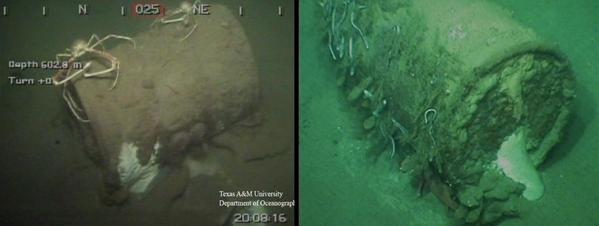
55-gallon drums of chemical weapons near the mouth of the Mississippi River found by Texas A&M University researchers. Photo:Texas A&M University
We have previously posted about unexploded bombs from World War II being exposed by drought along the Rhine and Mosel Rivers in Germany, about similar bombs being found in the port of Marseille and about World War II phosphorus munitions burning two beachcombers at a seaside resort in the north of the island of Usedom on the German Baltic coast. Now, as offshore drilling returns to the Gulf of Mexico following the BP Deepwater Horizon disaster, Texas A&M oceanographer William Bryant warns that the thousands of tons of bombs, ordnance and chemical weapons, including mustard gas, dumped by the US military in the Gulf after World War II, could pose a serious risk to new drilling.
World War II bombs, mustard gas in Gulf of Mexico need to be checked, experts warn
“The bottom line is that these bombs are a threat today and no one knows how to deal with the situation,” Texas A&M oceanographer William Bryant said in a statement ahead of a briefing he’ll give at a weapons disposal conference. “If chemical agents are leaking from some of them, that’s a real problem. If many of them are still capable of exploding, that’s another big problem.”
Photos taken during surveys show that some of the chemical weapons canisters, such as those that carried mustard gas, appear to be leaking materials and are damaged, Bryant and others on his team reported.
The surveys have turned up 10 dump sites at 60 and 100 miles out — and one of them had a pipeline running through it.
Texas has the closest dump, followed by Louisiana, “not far from where the Mississippi River delta area is,” Bryant said. “Some shrimpers have recovered bombs and drums of mustard gas in their fishing nets.
Thanks to Phil Leon for passing the articles along.

offshore oilfields analysis no matter how well conceived is a peripheral representation on their reality. Your blog is great. I appreciate you sharing this with the rest of us Rick.